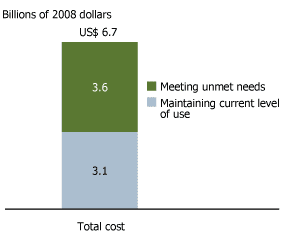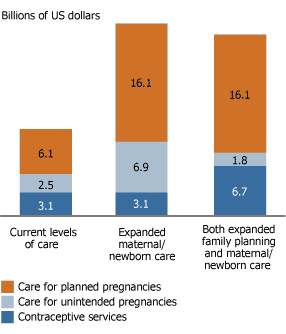
What Would It Cost to Meet Family Planning Needs in Developing Countries?
(February 2010) As many as 215 million women in developing countries want to avoid pregnancy but are not using an effective means of contraception.1 These women account for about 15 percent of the women of childbearing ages (15 to 49) in these countries. A new report from the Guttmacher Institute and the UN Population Fund (UNFPA), Adding It Up: The Costs and Benefits of Investing in Family Planning and Maternal and Newborn Health, estimates what it would cost to provide these women with family planning services, and enumerates some of the well-documented health benefits of preventing unintended pregnancies.2
Figure 1
Cost of Providing Modern Contraceptives to All Who Need Them, 2008

Source: Susheela Singh et al., Adding It Up (2009).
Avoiding unintended pregnancies also has demographic and economic benefits for the least developed countries in which most women with unmet needs for family planning live. Research shows that when women delay their next birth or have fewer children, the rate of population growth declines and the potential to educate, train, and meet the economic demands of a young population becomes easier. Slower population growth can yield savings on the costs of providing health, clean water, sanitation, and social services. Meeting women’s desires to avoid or postpone pregnancies also allows women more opportunities for education and employment, which can spur economic growth.
At least 600 million women use effective contraceptives now; what will it cost to reach an additional 215 million women? The report estimates that price tag at $3.6 billion annually. Most of this would cover program and other system costs; less than $1 billion would go for contraceptive supplies or health worker salaries.
About $3.1 billion is already spent each year on family planning, so the cost of covering the additional 215 million women would bring the total spent on family planning to $6.7 billion (see Figure 1). While this would more than double the amount now spent on family planning, it amounts to less than $5 per capita in developing countries. International family planning support currently comes from international donors and from the countries themselves. Because the countries with the highest levels of unmet need for contraception are also among the poorest, there is greater need in these countries for international donor assistance to supplement their own contributions. International support for family planning and other reproductive health services in less developed countries has fallen far short of commitments made by these donors to the 20-year Programme of Action of the International Conference on Population and Development held in 1994. According to Adding It Up, funding for family planning declined in absolute dollars by nearly half even as the number of women needing family planning grew by 25 percent.
What benefits would these expenditures bring? Current levels of family planning use already prevent about 188 million unplanned pregnancies, which in turn avert unplanned births, abortions, and miscarriages (see table).
Estimated Benefits From Universal Access to Modern Contraceptives in Less Developed
Countries, 2008 (numbers in millions)
| Current Contraceptive Use Levels | 100% of Unmet Need for Contraceptives Fulfilled |
Total |
|
|---|---|---|---|
| Unintended Pregnancies Averted | |||
| Unplanned Births | 53.6 | 21.8 | 75.4 |
| Abortions | 112.3 | 24.8 | 137.1 |
| Miscarriages | 21.9 | 6.8 | 28.8 |
| Deaths averted | |||
| Newborns | 1.2 | 0.6 | 1.8 |
| Mothers | 0.2 | 0.2 | 0.4 |
| Total Using a Modern Contraceptive Method | 603.1 | 214.4 | 817.5 |
Source: Susheela Singh et al., Adding It Up (2009).
If 100 percent of the unmet needs were met—if all the women in developing countries who wanted to postpone their next pregnancy or stop having children altogether used effective contraceptive methods—an additional 22 million unplanned births, 25 million abortions, and nearly 7 million miscarriages would be averted. And nearly one-third of the 500,000 annual maternal deaths would be prevented, as would the deaths of 640,000 infants. In sum, fulfilling unmet need for contraception would have enormous benefits for the lives of women, the health of children, and the strength of health systems.
Figure 2
Projected Cost of Providing Family Planning With or Without Maternal and Newborn Health Care

Source: Susheela Singh et al., Adding It Up (2009).
Beyond Contraceptives
Expanding family planning services is just part of what is needed to ensure better health for vulnerable mothers and children. The Guttmacher/UNFPA report also estimates the costs of improving maternal and newborn health care in low-income countries, saving lives and avoiding long-term health problems for millions of mothers and children.
These health care improvements are more expensive, but the analysis makes it clear that because family planning saves the lives of mothers and infants, investing in family planning along with providing an expanded package of care to mothers and newborns actually reduces the need for the maternal and child health care, and brings down the total cost (see Figure 2). Enabling all women who want to prevent or space their next birth to use effective contraception is cost-effective and improves health.
Meeting the unmet need for family planning and improving maternal and child health are crucial for countries to achieve the Millennium Development Goals (MDGs) by 2015. The MDGs cover a broad range of social and economic development indicators, including improved maternal and child health, higher educational attainment for girls, and reduced poverty and hunger.
Although many of the lowest-income countries will not meet all the MDGs in the next five years, increasing access to family planning will help most countries achieve MDG 5: improving maternal health.3 Lowering fertility and slowing population growth will move low-income countries closer to achieving many other MDG targets, enabling greater per capita spending on health, education, and poverty reduction, and increasing the likelihood that women and children will live healthy, productive lives.
Mary Mederios Kent is senior demographic editor at the Population Reference Bureau.
References
- This estimate includes women of childbearing age who report that they want to postpone a conception for at least two years or do not want to become pregnant at all; are currently married or sexually active and able to become pregnant; and are not using an effective contraceptive method.
- Susheela Singh et al., Adding It Up: The Costs and Benefits of Investing in Family Planning and Maternal and Newborn Health (New York: UNFPA and Guttmacher Institute, 2009), available online at www.unfpa.org/public/publications/pid/4461.
- MDG 5, Improve Maternal Health, requires reducing the maternal mortality ratio by three-quarters and achieving universal access to reproductive health services by 2015. Meeting these targets involves increasing the proportion of births attended by a skilled health person; increasing contraceptive prevalence; reducing the adolescent birth rate; increasing antenatal care; and reducing the unmet need for family planning. Read more about the United Nations Millennium Development Goals at www.un.org/millenniumgoals/maternal.shtml.
